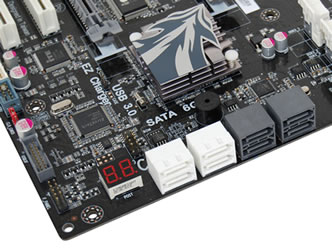Wrapping Things Up
When we published our Intel P55 motherboard roundup in 2009 the findings were much the same as those from our P35 motherboard roundup two years prior. It didn't really matter if you spent $100 or $300 on a motherboard, they all seemed to deliver the same level of performance whether you work or play.
This remains true in our P67 roundup. In terms of stock performance, the typical user is unlikely to notice a difference between the five boards in this review, so it's impossible to declare a single winner solely based on benchmark results. Each of the boards tested today excels in its own way and it's simply a matter of what features you need and how much cash you have to blow.
Starting with the cheapest boards first, we have the MSI P67A-GD55 ($160) and ECS P67H2-A2 ($195). As noted on page 14, MSI handed us the P67A-GD55 at the last minute and as its price would indicate, the board didn't really take charge in any meaningful benchmarks. It was nearly always in the middle or toward the bottom of our results.
The P67A-GD55 provided the worst results in our encoding, gaming and overclocking tests, the USB 3.0 results showed weak write performance and it ran the hottest while under load. Despite all that, the margin was generally slim and it was to be expected considering its baseline price.
Stepping things up, the ECS P67H2-A2 is going for about $35 more, which manifests in more features such as dual Gigabit LAN, eSATA and additional onboard SATA ports. It was also the second-best results in two out of three gaming benchmarks, power consumption and CPU temperature. Overclocking results were modest compared to the other boards. Meanwhile, its USB 3.0 performance was more consistent between front and rear ports, but it was still toward the bottom of the barrel with lousy writes.
Folks willing to spend more than $200 on a motherboard have even better boards to pick from, with the Asrock P67 Extreme6 ($210) being one of the most attractive options. Asrock's enthusiast board certainly offers a greater degree of features and a better overall build quality.
The P67 Extreme6 is littered with features, including plenty of USB 3.0 and SATA ports along with eSATA and Firewire support. It fetched another 35MHz when overclocking with our Sandy Bridge K series processor, it had the lowest power consumption and it was alongside Gigabyte with the best USB 3.0 read and write results. If the $210 asking price is a little rich for your taste, the toned down P67 Extreme4 version might be more accommodating for $160. You can expect to shed a few SATA and USB 3.0 ports, but overall the Extreme4 offers a great value if you're building an Enthusiast rig on a budget.
As the second most expensive board in our roundup, you'd expect the Asus P8P67 Deluxe ($240) to be one of the highest quality P67 motherboards available – and that's partially true. To highlight its negatives, the P8P67 Deluxe struggles to match the P67 Extreme6 for value and its USB 3.0 ports had the worst write performance we recorded.
To redeem itself, Asus' competitor elbowed its way to the top of our application and coding benchmarks, while scoring the highest in our overclocking benchmark with 4692MHz (46MHz ahead of Gigabyte's second place showing and 102MHz ahead of MSI's last place). It also had the best CPU and motherboard temperatures. It's hard to say whether the Asus P8P67 Deluxe is worth another $20 over the Asrock P67 Extreme6 however, maybe only if you plan to overclock heavily.
Finally, we have the grandaddy: Gigabyte's P67A-UD7. At $330, it is by far the priciest P67 motherboard featured in our roundup – though it's not the most expensive P67 motherboard available. We believe that title goes to the Asus Maximus IV Extreme, which costs a cool $370 and represents their premium Republic of Gamers line.
It's worth noting that Gigabyte hosts an extensive range of P67 motherboards that start at $100 up to the $330 of the P67A-UD7. The P67A-UD4 that we briefly evaluated in our original Sandy Bridge review is a very good option for $190, and is a happy medium from a value perspective. Having said that, the Gigabyte P67A-UD7 is the most desirable motherboard we examined in this roundup. This not a motherboard for the budget conscious or for those who sleep better knowing every last dollar was well spent.
While its overclocking abilities and general performance won't have you picking your jaw up from the floor, its functionality and build quality might. The P67A-UD7 supports up to ten USB 3.0 ports and provides more than 16 PCIe lanes for graphics cards with its four full-length PCIe x16 slots.
Thanks to its implementation of the Nvidia NF200 chip, all four PCIe x16 slots get x8 bandwidth, making it one of the best boards currently available for multi-GPU configurations. It scored the best on two out of three gaming benchmarks, it was alongside Asrock's P67 Extreme 6 with the top USB 3.0 performance, and it had the second-best overclocking results.
It's evident that Gigabyte didn't design this board for the typical user and it's probably not intended for the average high-end user either. That's a job for the UD5 or UD4. The P67A-UD7 is the ultimate motherboard for hardcore enthusiasts (read: wealthy). Overall, the Gigabyte premium offering has plenty of everything while it also does everything very well.
We can't pick what are the right features for you but putting everything together we consider the Asrock P67 Extreme6 to be the best all-around value for the enthusiast shopper. Asus' offering looks a bit more promising for overclockers, while Gigabyte's luxury board is hard to justify unless you don't mind burning cash and plan to couple it with an arsenal of GPUs, SSDs and a Level 10 case to boot.
